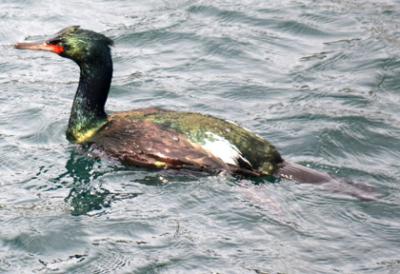
More Signs of Spring

The changing plumage of local birds provides another sign of spring. In the last column, I talked about how the resident birds already are beginning to perform their breeding season music. Another sign to watch for includes the switch in plumages from basic (winter) to breeding. If you have a bird feeder with thistle or sunflower seeds, over the coming months, watch how the American Goldfinch males shift from winter grayish yellow-green to their bright yellow summer feathers. Email me when you see the change begin with your birds.
Some birds everyone can watch for making plumage changes are the Pigeon Guillemots and cormorants by both the south and north end ferry docks. The Pigeon Guillemots in winter have white breast and head and grayish backs with white wing patches. They generally look like a messy grey/white duck diving along the dock or chasing each other, which they do more than the other waterfowl. I’ve already noticed some getting darker and by April they’ll be all jet black with white wing patches. They possess one splash of color, their bright red feet which sometimes show as they turn in flying or when paddling around. These birds will soon start nesting under the docks, with a lot of their “pee pee pee pee pee ee ee ee ee eeeeee” calls sounding as they chase for mates.
Spring makes telling apart our three cormorant species much easier as they change into breeding plumage. The smaller Pelagic Cormorant, which doesn’t always look so small, gets a white wing patch on its back, which the other two cormorant species lack. The orange pouch on the large Double-crested Cormorant gets much brighter and noticeable. The Brandt’s Cormorant is often very hard to tell from the similar sized Double-crested. But in March, the Brandt’s grows long white plumes on its back and if its head catches the light right, one can see a brilliant iridescent blue throat pouch, very different from the orange of the Double-crested.
All three cormorants sit on the end of the old dock at Tahlequah and on the piling dolphins at the north end. Sometimes all three species sit right next to each other allowing comparison of their plumage differences. The Brandt’s Cormorant has only started using the north end dock in the last few years and all three species now stay later in spring into June before leaving for their nesting territories, mostly out on the outer coast.
If you have a question about Vashon birds or an interesting sighting to report, email me at edswan@centurytel.net or call at 463-7976. I’m available also as a guide for bird watching on Vashon and trips to birding hot spots around Puget Sound. Right now, my second edition of The Birds of Vashon Island finally arrived from the printer after much delay. Order on-line by credit card from my website at www.theswancompany.com or mail a check for $31.45 (book and tax) to Ed Swan, 11230 SW 212th Place, Vashon, WA 98070. Off-Island delivery requires a total check of $35.50 in order to include shipping and handling.
- Login to post comments
